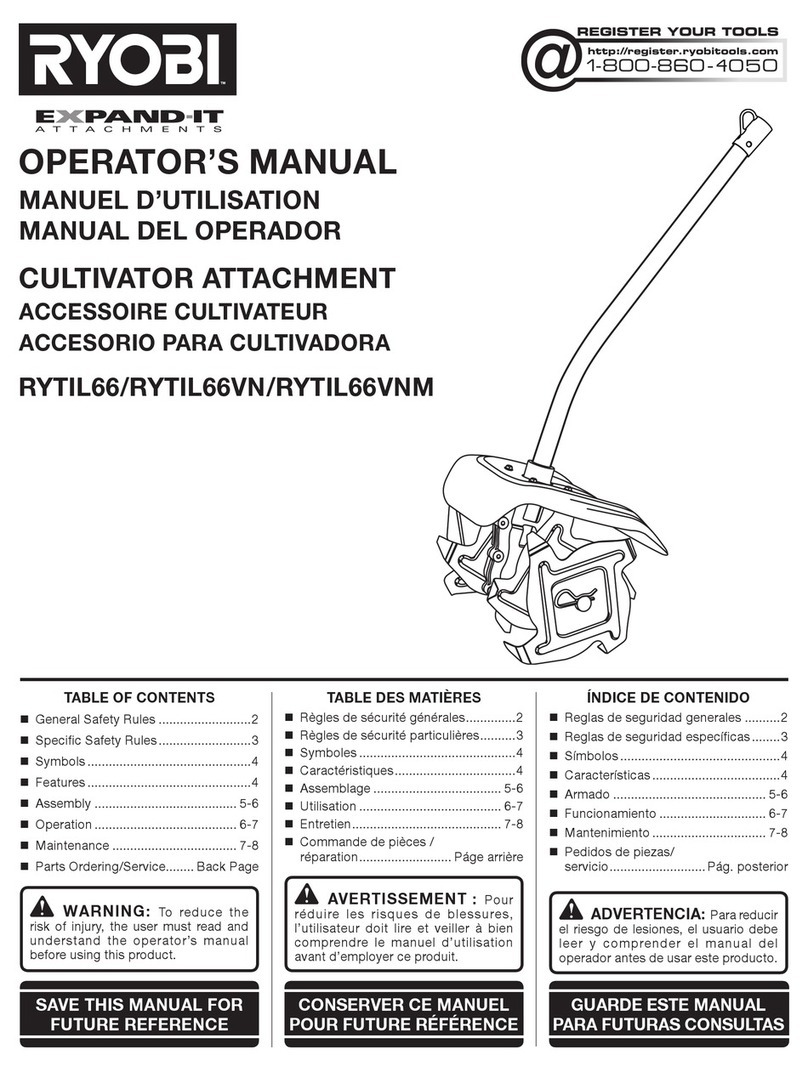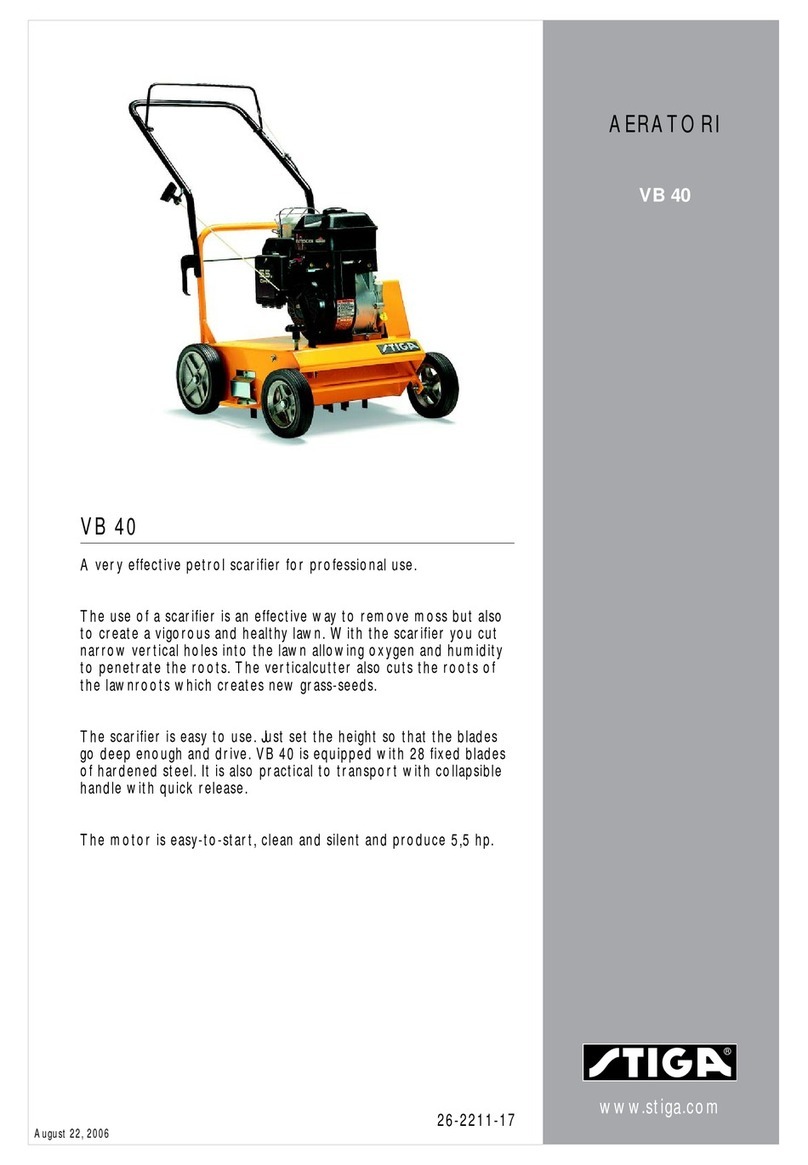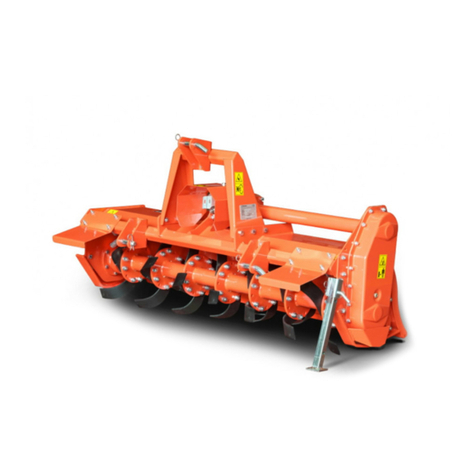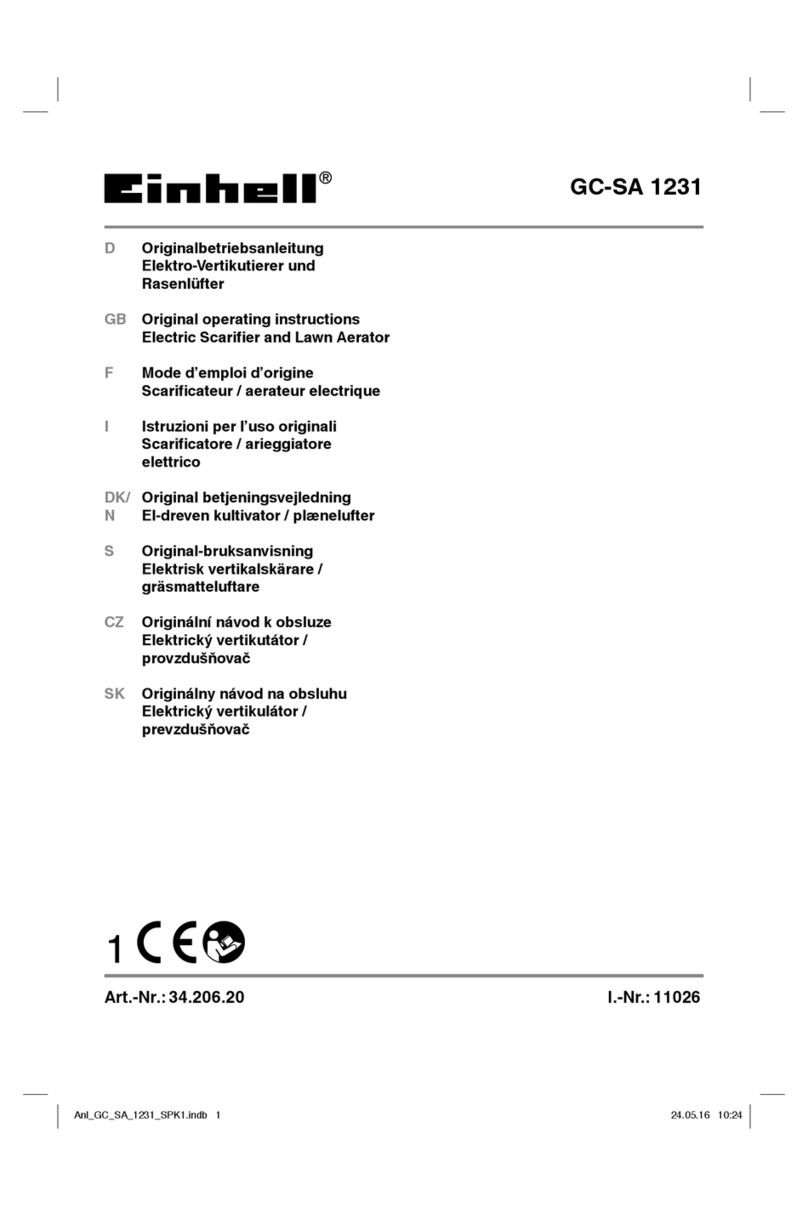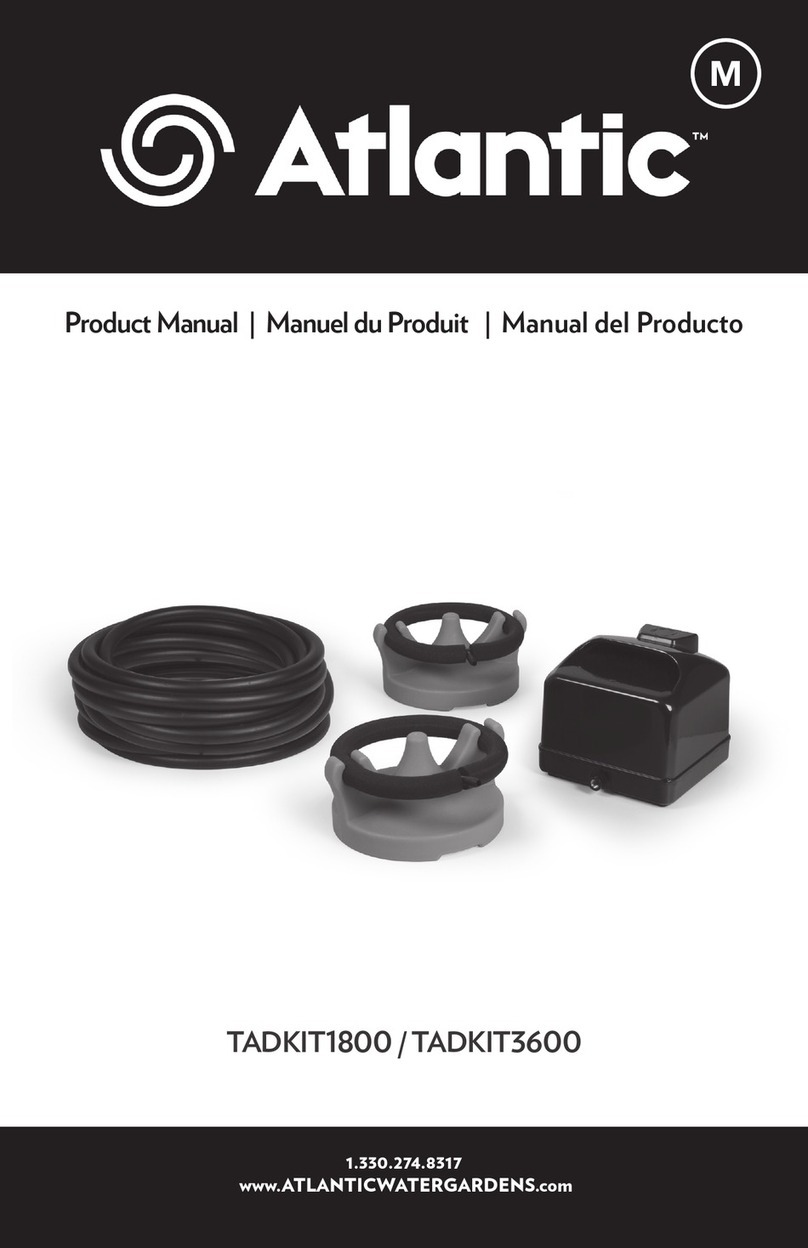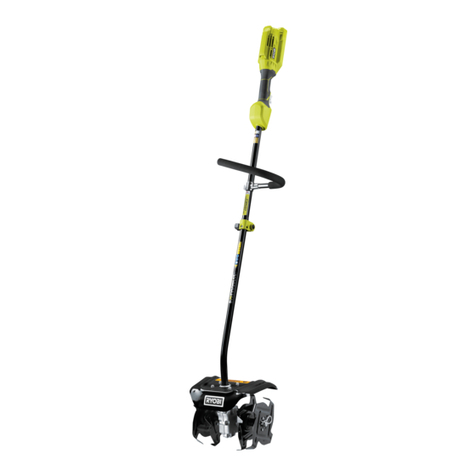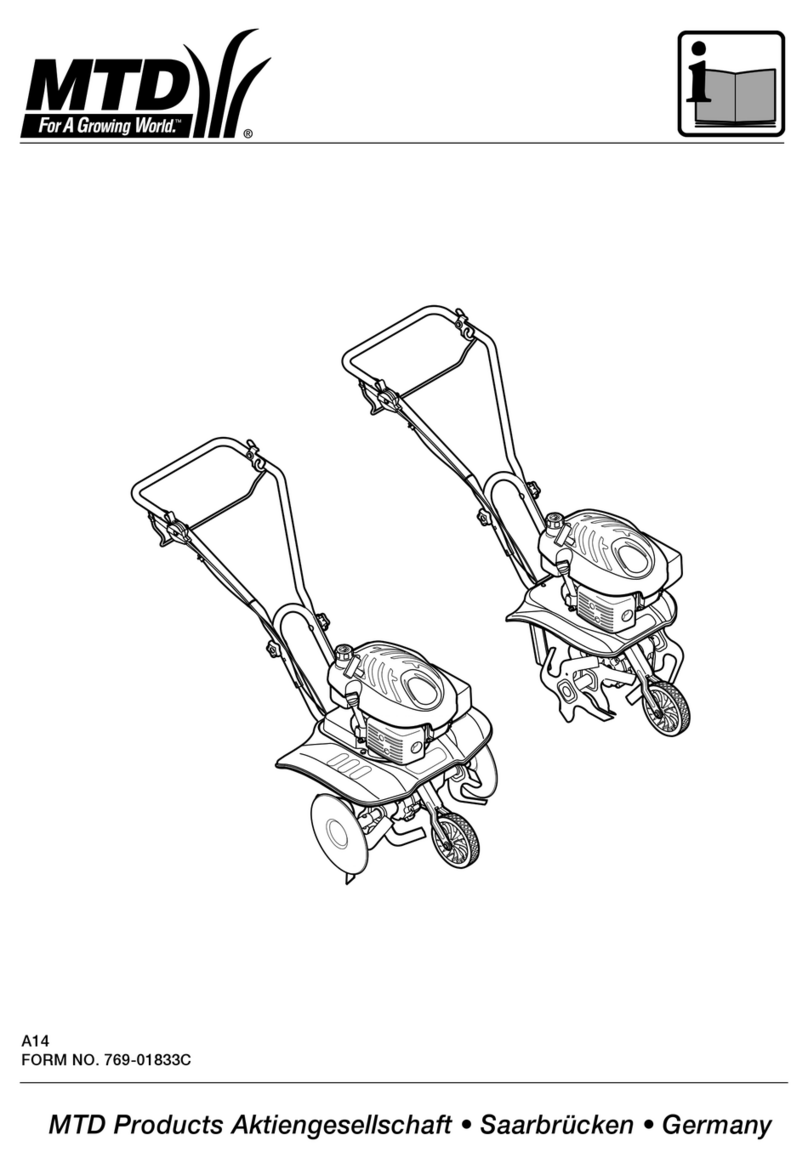Mech Marvels MM212FTT User manual

MECH MARVELS
FRONT TINE TILLER
MM212FTT
INSTRUCTION MANUAL
READ ALL INSTRUCTIONS AND WARNINGS BEFORE USING THIS PRODUCT.
Thank you for purchasing a Mech Marvels Tiller. This manual provides important information on proper
operation & maintenance. Read and save these instructions. Every effort has been made to ensure the
accuracy of this manual. These instructions are not meant to cover every possible condition and
situation that may occur. We reserve the right to change this product at any time without prior notice.
IF THERE IS ANY QUESTION ABOUT A CONDITION BEING SAFE OR UNSAFE,
DO NOT OPERATE THIS PRODUCT!
DO NOT RETURN THIS FRONT TINE TILLER TO THE RETAILER
If you experience a problem, have questions, or need parts for this product, please call Customer Service at
1-800-832-2966, Monday-Friday, 9 AM - 6 PM Central Time
. A copy of the sales receipt is required.
FOR CONSUMER USE ONLY NOT FOR PROFESSIONAL USE.
KEEP THIS MANUAL, SALES RECEIPT & APPLICABLE WARRANTY FOR FUTURE
REFERENCE. UNIT SERIAL #________________________
FOR FURTHER INFORMATION AND MANUAL UPDATES VISIT:
WWW.MECHMARVELS.COM
Version 20211230

NEED HELP? 1-800-832-2966
2
*
CARBON MONOXIDE
Running this tiller indoors
CAN KILL YOU IN MINUTES
Engine exhaust contains carbon monoxide (CO). This is a poison you cannot see or smell. If you
can smell the exhaust, you are breathing CO. But even if you cannot smell the exhaust, you could
be breathing CO.
CALIFORNIA PROPOSITION 65
WARNING: This product, or the exhaust from this product, may contain chemicals known to
the State of California to cause cancer, birth defects, or other reproductive harm.
For more information, view OEHHA's Proposition 65 page: https://www.p65warnings.ca.gov
Contains LEAD. May be harmful if eaten or chewed. May generate dust containing lead. Wash hands
after use and keep out of reach of children.

NEED HELP? 1-800-832-2966
3
Contents
SAFETY SYMBOLS, WORDS, AND LABELS.............................................................................................................................. 5
Operator Responsibilities................................................................................................................................................... 7
Fuel Safety ........................................................................................................................................................................ 7
Site Preparation and Safety............................................................................................................................................... 8
Operational Precautions During Use ................................................................................................................................. 8
Safety of Children .............................................................................................................................................................. 9
Maintenance and Adjustment ............................................................................................................................................ 9
PACKAGE CONTENTS ............................................................................................................................................................. 10
MACHINE COMPONENTS ........................................................................................................................................................ 11
ASSEMBLY INSTRUCTIONS .................................................................................................................................................... 12
Unboxing the Tiller........................................................................................................................................................... 12
Wheel Assembly.............................................................................................................................................................. 12
Attach Wheel Assembly to the Tiller ................................................................................................................................ 12
Tine Installation ............................................................................................................................................................... 13
Handlebars (lower) .......................................................................................................................................................... 13
Handlebars (upper).......................................................................................................................................................... 14
Tine Shields..................................................................................................................................................................... 14
Depth Regulator .............................................................................................................................................................. 14
PREPARING THE MACHINE FOR USE.................................................................................................................................... 15
Using this Machine for the First-Time .............................................................................................................................. 15
STARTING THE MACHINE........................................................................................................................................................ 16
Pre-Start Inspection......................................................................................................................................................... 16
Starting the Tiller ............................................................................................................................................................. 17
USING THE MACHINE .............................................................................................................................................................. 17
Engine Speed Adjustment ............................................................................................................................................... 18
Tilling ............................................................................................................................................................................... 18
STOPPING THE MACHINE ....................................................................................................................................................... 19
Tiller Use and Adjustments......................................................................................................................................................... 20
Transport/Tilling Modes ................................................................................................................................................... 20
Handlebar Adjustment ..................................................................................................................................................... 20
Depth Regulator Adjustment............................................................................................................................................ 21
MAINTENANCE/CARE .............................................................................................................................................................. 22
Recommended Maintenance Schedule........................................................................................................................... 22
To Maximize Product Life ................................................................................................................................................ 23
Engine:.................................................................................................................................................................... 23
Transmission:
........................................................................................................................................................ 23
Axle Shaft:
.............................................................................................................................................................. 23
Tines:
...................................................................................................................................................................... 23
Air Filter:
................................................................................................................................................................. 24

NEED HELP? 1-800-832-2966
4
Replacing the Drive Belt
................................................................................................................................................ 24
To remove and install the drive belt: ....................................................................................................................... 24
Cleaning the Machine
.................................................................................................................................................... 25
STORAGE PROCEDURES........................................................................................................................................................ 25
TROUBLESHOOTING
.............................................................................................................................................................. 26
SPECIFICATIONS...................................................................................................................................................................... 27
WARRANTY............................................................................................................................................................................... 28

NEED HELP? 1-800-832-2966
5
SAFETY SYMBOLS, WORDS, AND LABELS
Warning and Important Safety Instructions appearing in this manual are not meant to cover all possible conditions and
situations that may occur. Common sense, caution and care must be exercised when operating or cleaning tools and
equipment.
Always contact your dealer, distributor, service agent or manufacturer about problems or conditions you do not understand.
This is the safety alert symbol. It is used to alert you to
potential personal injury hazards. Obey all safety
messages that follow this symbol to avoid possible
injury or death.
DANGER indicates an imminently hazardous situation
which, if not avoided, will result in death or serious injury.
WARNING indicates a potentially hazardous situation which,
if not avoided, could result in death or serious injury.
CAUTION indicates a potentially hazardous situation which,
if not avoided, may result in minor or moderate injury.
CAUTION used without the safety alert symbol indicates a
potentially hazardous situation which, if not avoided, may
result in property damage.
Safety Warning Symbols—The following symbols may be present on your machine. Carefully read and understand their meaning.
Look for this symbol to point out important safety precautions. It means: Attention! Become Alert! Your Safety Is Involved.
Read operator’s manual before operating this machine. Failure to follow directions could result in serious injury.
Thrown objects. Remove all rocks, stones, and foreign objects which could be thrown by machine. Work protective clothing and keep
all children and bystanders clear of the work area.
Do NOT touch hot muffler or cylinder. These parts are extremely hot from operation and may remain hot for a period of time after
operation.
Rotating tines can cause serious injury. Keep hands, feet, and clothing away.
Engine exhaust contains carbon monoxide, an odorless and deadly gas. NEVER run unit indoors or in a poorly ventilated area.
To reduce risk of fire, clean up any spilled gas or oil and keep unit free from debris. Gasoline is extremely flammable. Allow machine to
cool completely before refueling.
Disconnect spark plug wire prior to clearing the tines or servicing the machine.
Wear eye protection when using this machine.
Wear hearing protection when using this machine.

NEED HELP? 1-800-832-2966
6
Control and Operating Symbols—The following symbols may be present on your machine. Carefully read and understand their meaning.
Oil Fill Location:
Do Not Overfill.
Fuel ON/OFF Valve: Move fuel valve lever to the ON position to operate the machine.
Choke Lever: Move choke lever to start position (closed) for cold engine starting. Gradually move the choke
lever to the run (open) position once the engine is started, or for warm engine starting.
Throttle Control: Move throttle lever to the left to increase engine speed. Move throttle lever to the right to
decrease engine speed.
Clutch Lever: Squeezing the upper lever towards the handlebar engages the wheels and tines for forward
travel/tilling.
IMPORTANT SAFETY INSTRUCTIONS
Before using this machine and if you have any questions regarding the hazard and safety notices listed in this manual and/or on this machine,
call 1-800-832-2966, Monday - Friday, 9 AM - 6 PM Central Time.
Carbon Monoxide Gas: When in operation, the exhaust from this machine contains poisonous carbon monoxide gas.
Carbon monoxide gas is both odorless and colorless and may be present even if you do not see or smell gas. Breathing this poison gas
can lead to headaches, dizziness, drowsiness, loss of consciousness and eventually death.
Use this machine ONLY outdoors in non-confined areas.
Keep at least several feet of clearance on all sides to allow for proper ventilation for this machine.
High Temperatures: This machine produces heat when in operation. Temperatures near the exhaust can exceed 150° Fahrenheit (65° Celsius).
Do not touch hot surfaces. Observe all warning placards on this machine denoting hot surfaces.
Allow this machine to cool for several minutes after use before touching the engine, muffler, or other areas that are hot during operation and before storing or
transporting the machine.
Hot exhaust may ignite some materials. Keep flammable materials away from this machine.
Keep several feet of clearance on all sides of this machine during operation. Do not enclose this machine in any structure.
Usage: Prolonged exposure to high noise levels can be hazardous to hearing.
Always wear ANSI-approved hearing protection when operating or working around the machine when it is running.
Anytime you are servicing this machine:
To prevent accidental starting, turn the engine kill switch to the “Off” position.
Disconnect the spark plug lead from the spark plug, and secure it away from the spark plug.
Keep hands, feet, and clothing away from moving parts of the machine until it is made safe.
Carefully inspect the area where the tiller will be used:
Thoroughly inspect the area where the tiller is to be used and remove all foreign objects
Your equipment can propel small objects at high-speed causing personal injury or property damage.
Stay away from breakable objects, such as house windows, auto glass, greenhouses, etc.
Check that all nuts and bolts are tight and equipment is in good condition before each use.

NEED HELP? 1-800-832-2966
7
Operator Responsibilities
➢Carefully read and follow these safety instructions. Failure to do so can result in serious injury.
➢Know your product. Read and understand this manual before use. Compare the illustrations to unit. Learn location and
function of all controls.
➢Thoroughly understanding the unit before use will result in the best performance and safety.
➢Keep area of operation clear of all bystanders, particularly small children and pets.
➢Only allow responsible individuals, who are familiar with the instructions, to operate the tiller.
➢Do not operate the tiller while under the influence of alcohol, drugs, or other medication which can cause drowsiness or
affect your ability to operate this machine safely.
➢Do not use this machine if you are mentally or physically unable to operate the machine safely.
➢Never operate the tiller without good visibility or light.
➢Follow all instructions when assembling the unit. If the unit was purchased in assembled condition, the operator must
check the unit carefully to make sure it was assembled according the instructions in the manual before use.
➢Regularly inspect the machine. Make sure parts are not bent, damaged, or loose.
➢Use this equipment for its intended purpose only.
➢Operate the unit only with guards, shields, and other safety items in place and working correctly.
➢Service the unit only with authorized or approved replacement parts.
➢Complete all unit maintenance and adjustments according to the instructions in this manual
Fuel Safety
➢Gasoline is extremely flammable, and gasoline vapors can explode if ignited. Handle with care.
➢Use only approved containers for transport and storage.
➢Check fuel supply before each use, allowing space for expansion when filling, as the heat of the engine and/or sun can
cause fuel to expand.
➢Fill fuel tank outdoors with extreme care. Never fill fuel tank indoors.
➢Never remove gas cap or add fuel with the engine running. Allow engine to cool before refueling.
➢Do not smoke while refueling.
➢Never fill gasoline containers or the tiller fuel tank inside of a vehicle or in a truck bed. Accidental electrical static discharge
can ignite fuel vapors which could result in serious injury or death.
➢After refueling, replace fuel tank cap securely and wipe up spilled fuel.
➢Never store fuel, or a tiller with fuel in the tank, inside a building where fumes may reach a source of ignition. Ignition
sources that may be present are items such as water heaters, space heaters, and clothes dryers.
➢To reduce the risk of fire, keep the tiller free of grass, leaves, or other debris build-up.
➢Allow the engine to cool completely before storing in any enclosure.
➢Always refer to the storage instructions for important details if the tiller is to be stored for an extended period of time.

NEED HELP? 1-800-832-2966
8
Site Preparation and Safety
➢Thoroughly inspect the area where the tiller is to be used and remove all foreign objects. Your equipment can propel small
objects at high-speed causing personal injury or property damage. Stay away from breakable objects, such as house
windows, auto glass, greenhouses, etc.
➢Keep area of operation clear of all bystanders, particularly small children and pets.
➢After striking a foreign object, stop the engine. Remove the wire from the spark plug and keep the wire away from the plug
to prevent accidental starting. Thoroughly inspect the tiller for any damage. If damaged, have the equipment repaired by a
trained technician before restarting and operating.
➢Only allow responsible individuals, who are familiar with the instructions, to operate the tiller.
➢Never allow children or young teenagers to operate the tiller.
Operational Precautions During Use
➢Always wear ANSI compliant safety goggles or safety glasses with side shields when operating the tiller to protect your
eyes from foreign objects, which can be thrown from the unit.
➢Wear appropriate clothing such as a long-sleeved shirt or jacket. Also wear long trousers or slacks. DO NOT wear shorts.
DO NOT wear loose clothing which could get caught in this equipment.
➢Always wear work gloves and sturdy footwear such as leather work shoes or short boots. These will protect ankles and
shins from small sticks, splinters, and other flying debris, and improve traction.
➢Do not put hands or feet near or under rotating parts.
➢Disengage clutch lever and stop engine before leaving the tiller in operating position. Wait until the tines come to a
complete stop before removing debris or making any adjustments to the tiller.
➢Do not attempt to till hard soil, till too deep or till at too fast a rate that can overload the tiller.
➢If the tiller should start to vibrate abnormally, stop the engine, disconnect the spark plug wire and prevent it from touching
the spark plug. Check immediately for the cause. Vibration is generally a warning of trouble
➢Exercise extreme caution when operating on or crossing gravel drives, walks, or roads. Stay alert for hidden hazards or
traffic.
➢Exercise caution to avoid slipping or falling. Always be sure of your footing; keep a firm hold on the handle and walk; never
run. Never operate the tiller at high speeds on slippery surfaces.
➢Watch for holes, ruts, bumps, or other rough ground. Tall grass can hide obstacles.
➢Never attempt to start the tiller unless the wheels are in a stable position. Always start the tiller on a level surface.

NEED HELP? 1-800-832-2966
9
Safety of Children
➢Tragic accidents can occur if the operator is not alert to the presence of children. Children are often attracted to the tiller
and the tilling activity.
➢Keep children out of the tilling area and under the watchful care of a responsible adult.
➢Never assume that children will remain where you last saw them.
➢Be alert and turn tiller off if children enter the area.
➢Before and while moving backwards, look behind and down for small children.
➢Never allow children to operate the tiller.
➢Use extra care when operating near blind corners, shrubs, trees, or other objects that may obstruct vision.
Maintenance and Adjustment
➢Stop the engine before cleaning, repairing, or inspecting the unit. Make sure all moving parts have stopped. Let the engine
cool, disconnect the spark plug wire and move it away from the spark plug.
➢Keep the tiller in safe working condition. Check all fasteners at frequent intervals for proper tightness.
➢When servicing or repairing the tiller, do not tip the machine over or up unless specifically instructed to do so in this
manual. Service and repair procedures can be done with the tiller in an upright position. Some procedures will be easier if
the machine is lifted on a raised platform or working surface.
➢Use only original equipment or authorized replacement parts.
➢Never tamper with safety devices. Check their proper operation regularly.
➢Do not change the engine governor setting.
➢Clean and replace safety and instruction decals as necessary.
➢To guard against engine over-heating, always have engine filters mounted and clean.

NEED HELP? 1-800-832-2966
10
PACKAGE CONTENTS
The following items are supplied with this MECH MARVELS machine. Verify that all items are included.
STOP!
If there are missing items,
call 1-800-832-2966 Monday - Friday, 9 AM - 6 PM Central Time
for customer service.
DO NOT RETURN THIS MACHINE
TO THE RETAILER.
Item List:
(3) Wire locking pins
(2)
Wheels
Wheel Bracket
(2) Lower handlebar components
(2) Tine Shields
Left and right tine assemblies
(1)
Depth regulator
(2) Sets of saddle bolts and handlebar knobs
Assorted Hardware, see Quick Start Guide for details

NEED HELP? 1-800-832-2966
11
MACHINE COMPONENTS
Observe the locations and functions of the various components and controls of this machine.
1.
Forward Control Lever
7.
Throttle Control
13.
Depth Regulator
2.
Fuel Tank
8.
Recoil Starter
14.
Oil drain plug
3.
Spark Plug
9.
Engine Switch
15.
Oil Fill/Dipstick
4.
Air Filter
10.
Tine/Debris Shield
5.
Choke Lever
11.
Tines
6.
Fuel Valve
12.
Wheels
15
14
13
11
9
2
3
7
6
4
10
8
5
1
12

NEED HELP? 1-800-832-2966
12
ASSEMBLY INSTRUCTIONS
Unboxing the Tiller
➢The tiller comes with the majority of assembly completed.
➢Remove all parts and packaging components.
➢Use a utility knife to cut all four vertical edges and lay the box side panels flat around the tiller.
➢Remove any remaining packaging.
➢Assembly can be done sitting on the cardboard to protect the finish.
Wheel Assembly
1) Locate the wheel bracket and
wheels.
2) Place one 13mm washer on each
wheel axle.
3) Slide one wheel on each axle.
4) Place one 13mm washer on each
axle outside each wheel.
5) Secure the washers and wheels to
the wheel bracket using the
supplied circlips.
Attach Wheel Assembly to the Tiller
1) Ensure the tiller main body is on a stable surface.
2) Align wheel assembly with the frame brackets on the
rear of the tiller.
3) Attach the wheel assembly to the tiller main body pivot
holes using the 8mm shoulder bolts.

NEED HELP? 1-800-832-2966
13
Tine Installation
1) Locate the tine assemblies
2) Slide the inboard tines on the left and right tine axles.
3) Note that tines are directional, and are marked with
arrows to indicate proper orientation. If unmarked, the
sharper edge of the tines will face forward.
4) Align inboard tine and axle holes.
5) Secure tines to axles by inserting the 10mm bolts with
washers through both the tines and the axles.
6) Install the remaining 10mm washers
and lock nuts.
7) Securely tighten the lock nuts on the
bolts for the inboard tines.
8) Slide the outboard tines into place.
9) Align the holes on the outboard tines
with the outboard holes on the
inboard tines.
10)Secure the outboard tines by
inserting the wire locking pins
through both inboard and outboard
tine holes.
11)Ensure the wire lock pivots up and over the tine axles, and stretch it over the end of the pin to secure it on
each side.
12)For a narrower tilling path, or for cultivating, the outboard tines can be left off, or removed from, the machine.
Handlebars (lower)
1) The lower handlebar pieces are attached to the
sides of the unit main body.
2) Align the lower handle bar holes with the lower
holes in the unit main body. Note: these are left
and right units, align so the concave upper portion
faces inward.
3) Install the 8x45mm bolts on each side using 1
shaped washer per side, but do not tighten
completely at this time.
4) Align the upper holes with the front height
adjustment holes.
5) Install the 8x40mm bolts, using 1 shaped washer
per side here as well.
6) Tighten all bolts (upper and lower) at this time.
M8 X 40 Bolts
M8 X 45 Bolts
M8 X 40 Bolts
M8 X 45 Bolts
Height Adjustment Holes
Lower Holes

NEED HELP? 1-800-832-2966
14
Handlebars (upper)
1) Hook the end of the clutch cable into the lever.
2) Route the cable into the cable bracket in the middle of the
upper handlebar assembly.
3) Slide the upper handlebar assembly down into the lower
handlebar assembly.
4) Align the bolt holes, and insert the saddle bolts and secure
with the handle knobs.
5) Ensure the cable is routed without being pinched or caught.
6) The cable can be secured to the handlebars using cable ties.
Tine Shields
1) Install the tine shields.
2) Place the outer tine shield underneath the main tine shield.
3) Secure each outer shield using the 6mm bolts, washers, and
nuts.
4) Securely fasten the center bolts first, then tighten the outer
two bolts on each side.
Depth Regulator
1) Tip the tiller forward.
2) Insert the depth regulator into the depth regulator bracket
between the wheels.
3) Insert the wire locking pin through the bracket and depth
regulator, ensuring the wire captures the end of the pin.

NEED HELP? 1-800-832-2966
15
PREPARING THE MACHINE FOR USE
Using this Machine for the First-Time
STOP!
The following section describes the required steps for preparing this machine for the first use. Improper assembly or failure to correctly
perform these steps can damage this machine and/or shorten its life. If you are still unsure about how to perform any of these steps
after reading this section, call 1-800-832-2966 Monday - Friday, 9 AM - 6 PM Central Time for customer service.
Once assembled, if this machine is being used for the first time, the following steps are required to prepare it for operation:
Step 1 - Add Oil
This machine requires engine oil to function. FAILURE TO ADD ENGINE OIL WILL RESULT IN SERIOUS ENGINE DAMAGE! Engine oil is a
major factor affecting engine performance and service life.
When new from the package, this machine contains no oil in the engine crankcase.
Add the correct quantity of oil before operating this machine for the first time. When replenishing/changing oil for subsequent use of this machine,
always ensure that this machine has the correct quantity of oil. A bottle of engine oil is included for your convenience. Always use a high-quality
detergent motor oil with an API rating of SG, SH, SJ or higher.
Model MM212FTT Oil Capacity
17.0 Ounces
Oil Type Recommended
SAE10W-30
To check/add oil:
1.
Confirm that the machine is on a level surface. Set the depth regulator lever so the main frame
of the tiller is level, or put the wheels in transport position.
2.
Unscrew the oil filler/dipstick cap from the engine and wipe it clean with a clean cloth.
3.
Insert the dipstick back into the engine, but do not screw it in. Remove the dipstick and check
the oil level.
4.
The oil level should be to the upper limit mark, if not add oil.
5.
Using a funnel, add high detergent (automotive) motor oil to fill the engine crankcase to the
correct level. SAE10W-30 oil is recommended for general, all- temperature use.
When the engine
crankcase is full, the oil level should reach nearly all the way up to the top of the lower
threads as illustrated.
Do not overfill.
6.
Replace the oil filler/dipstick cap and clean up any spilled oil. When completing an
oil change, please be sure to properly capture and recycle the old engine oil.
➢Note: The transmission comes factory filled with the proper type and
amount of lubricant.
Step 2 –Fueling
Add Unleaded gasoline only with an octane rating of 87 or higher.
DO NOT USE E85, OR FUEL WITH MORE THAN 10%
ETHANOL CONTENT. DOING SO CAN CAUSE ENGINE DAMAGE.
Be sure to avoid overfilling, leave 1 inch of air space in the
top of the tank when fueling to allow for expansion. Maximum Capacity: 3.6 Liters

NEED HELP? 1-800-832-2966
16
STARTING THE MACHINE
Pre-Start Inspection
➢Make sure all safety guards are in place and all nuts and bolts are secure.
➢Check oil level, and verify machine is properly filled. The machine is shipped without oil in the engine, oil
must be added before starting the engine.
➢Inspect air cleaner for cleanliness.
➢Check the fuel supply. Use fresh unleaded gasoline with an octane rating of 87 or higher. Do not use
gasoline containing more than 10% ethanol. Use of non-ethanol fuel is best. We recommend the continuous
use of a fuel additive/stabilizer to counteract the effects of ethanol. These additives also prolong the shelf life
of gasoline. Fill the fuel tank no closer than 1 inch from top of tank to provide space for expansion.
➢Be sure spark plug wire is attached and spark plug is tightened securely.
➢Check position of wheels, and ensure unit is level and in a stable position.
➢Check depth regulator lever position.
➢Examine underneath and around engine for signs of oil or fuel leaks.
➢Inspect fuel hoses for tightness and fuel seepage.
➢Look for signs of engine damage.
➢Remove any debris from muffler area and recoil starter.
Please do not start your tiller until you have read this manual in its entirety, especially the sections regarding operator safety.
Always perform the pre-start checklist before starting the engine.
Gasoline is highly flammable and must be handled with care. Never fill the tank when the engine is hot or running. Always move
outdoors to fill the fuel tank.
The tiller must be in a stable position when the engine is running. Never start the machine on uneven terrain, or where it will
not rest solidly on its own.
The depth regulator should be adjusted properly before starting the machine. Keep hands and feet away from all rotating parts
when starting the machine.

NEED HELP? 1-800-832-2966
17
Starting the Tiller
The controls required to start and run the tiller are located on the engine and are marked with the
icons for choke, slow and fast for the throttle, and on/off for the fuel valve.
Starting a Cold Engine
1) Turn the engine switch to the “on” position.
2) Move the fuel valve lever to the “on” position.
3) Move choke lever to the left for full choke, the “start” position.
4) Move throttle control lever to “start” or “fast” position.
5) Pull starting cord out slowly one time and allow to return normally, maintaining control of the starter cord at all
times, do not allow it to “snap back”.
6) Pull starter cord rapidly, and allow rope to return normally, maintaining control of the starter cord at all times,
do not allow it to “snap back”. Repeat until the engine starts.
7) When the engine starts, gradually move the choke lever to the “run” position and adjust the throttle to the
desired speed.
8) Normal throttle position for best machine operation will be the “fast” position.
Restarting a Warm Engine
1) Normally a warm engine will not require the use of the choke.
2) Turn the engine switch as well as the fuel valve lever to the “on” position.
3) Move the throttle control lever to the “start” or “fast” position.
4) Pull starter cord rapidly, and allow rope to return normally, maintaining control of the starter cord at all times,
do not allow it to “snap back”. Repeat until the engine starts.
5) Normal throttle position for best machine operation will be the “fast” position.
USING THE MACHINE
Although reading this manual and the safety instructions it contains will provide you with the necessary basic
knowledge to operate this equipment safely and effectively, we have placed several safety labels on the tiller to
remind you of this important information while you are operating the unit.
These important safety labels are shown here to help familiarize you with the operational and safety messages
you will see as you perform normal tilling operations. Please review these labels now. If you have any
questions regarding their meaning or how to comply with these instructions, reread the complete safety
instruction text on the preceding pages, or contact us at 1-800-832-2966 for any questions.

NEED HELP? 1-800-832-2966
18
Engine Speed Adjustment
➢When idling, adjust the throttle control to the “slow” position. This will conserve fuel, reduce noise, and
reduce the load on the engine when not tilling thereby extending engine life.
➢For normal tilling, move the throttle control lever to the “fast” setting for best performance.
Tilling
1) Adjust the depth regulator to the desired height.
2) Push down on the clutch control lever. This will start the tines moving and the tiller will begin to turn the
dirt.
3) You can stop the tiller’s movement at any time by releasing the clutch control lever.
4) You can also typically slow the forward movement when tilling by applying slight downward pressure on
the handlebars.
5) Adjust the depth regulator one step at a time to till more deeply. It is always best to make multiple
passes adjusting the depth regulator one step at a time.
6) The clutch control lever is non-locking for safety.
7) Do not lock the control lever in place by any means, doing so is extremely dangerous! The lever is
designed to release automatically without input from the Operator. Releasing the lever stops the tines
from rotating and brings the machine to a complete stop.
Clutch Control Lever
Engages tines into forward motion. Pushing down on the clutch control
lever (squeezing towards the handlebar) engages the tines. Releasing
the lever stops the tines and brings the tiller to a complete stop.

NEED HELP? 1-800-832-2966
19
To stop the tines at any time, release drive control lever. Always release drive control levers AND ENSURE THE TINES
HAVE STOPPED ROTATING before releasing the machine.
Raise or lower the depth regulator one hole at a time, testing tiller operation after each adjustment. Adjusting the depth
regulator too high or low can result in loss of control of the tiller! It is easier and safer to make multiple passes and allow
the machine to do the work.
Always press the clutch control lever down completely onto the handle bar. Failure to do so may result in excessive drive
belt wear and premature drive belt failure.
Temperature of muffler and nearby areas may exceed 150˚F. Avoid these areas. Engine and surrounding parts become
extremely hot during normal use and will cause serious burn injuries if touched before the engine has cooled. Allow
engine to cool completely before touching these hot surfaces.
STOPPING THE MACHINE
➢To stop the machine from moving, release the lever. This stops movement of the tines, but leaves the
machine running.
➢Once the tines have stopped rotating, turn the Engine On/Off Switch to “Off” to stop the engine.
➢For storage purposes, you can also turn the fuel valve to “Off” and allow the engine to run out of fuel and
stop.
➢Never use the choke control to stop the engine. Backfire or engine damage may occur.

NEED HELP? 1-800-832-2966
20
Tiller Use and Adjustments
The machine should always be on flat, level ground, and the engine should always be off before making any of these
adjustments to the machine.
Transport/Tilling Modes
To place the machine in tilling or transport modes.
To place the wheels in the transport position:
1) Adjust the depth regulator to the middle position.
2) Using the handlebars, rotate the machine forward on the
tines.
3) Allow the wheel assembly to rotate forward under the
engine.
4) Move the unit by pulling it towards you (rearward). This
will keep the wheels locked in the transport position.
To place the wheels in the tilling position:
1) Rotate the wheel assembly back towards you.
2) This can be facilitated by rocking the unit forward on the tines.
3) Adjust the depth regulator to the desired position.
Handlebar Adjustment
The ideal height of the handlebar varies with operator height and the depth of tilling
To adjust handlebar height:
1)
Remove top bolts on each side of the lower
handlebar.
2)
Loosen the lower bolts but do not remove them.
3)
Align handlebar to desired height holes on the
handlebar mount.
4)
Re-install bolts and washers.
5)
Retighten all four bolts securely.
M8 X 40 Bots
M8 X 45 Bolts
M8 X 40 Bolts
M8 X 45 Bolts
Height Adjustment Holes
Lower Holes
Table of contents
Other Mech Marvels Tiller manuals


